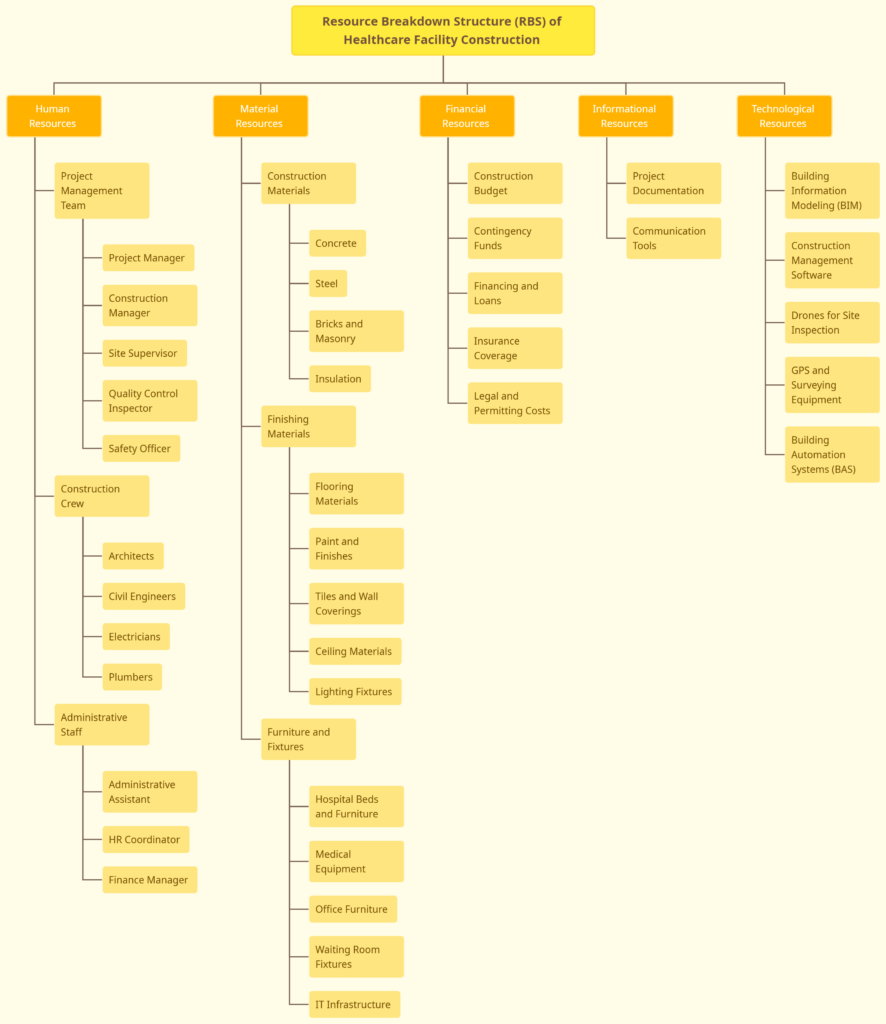
Navigating Resources in Healthcare Facility Construction
This mind map provides a detailed and organized breakdown of the various resources involved in constructing a healthcare facility. The RBS is structured into categories that encompass human resources, material resources, financial resources, informational resources, and technological resources. Within human resources, roles such as Project Manager, Construction Manager, and various construction crew members are outlined, emphasizing the diverse skill sets required for successful healthcare facility construction. Material resources cover everything from construction materials like concrete and steel to finishing materials such as flooring, paint, and lighting fixtures. Financial resources are intricately detailed, including construction budget, contingency funds, financing, loans, insurance coverage, and legal and permitting costs. Informational resources highlight the importance of project documentation and communication tools, while technological resources encompass Building Information Modeling (BIM), construction management software, drones for site inspection, GPS and surveying equipment, and Building Automation Systems (BAS). This mind map provides a comprehensive view of the multifaceted resources crucial for the successful planning and construction of a healthcare facility.
Comprehensive Look at the Tangibles and Intangibles
Resources in project management can be broadly classified into two main categories: human resources and material resources. Human resources encompass the people involved in a project, including project managers, team members, stakeholders, and administrative staff. This category is crucial for decision-making, project coordination, and the execution of tasks. On the other hand, material resources involve the physical items necessary for project implementation. This includes raw materials, equipment, and any tangible items required to complete the project. In construction, for instance, materials like concrete, steel, and finishing materials fall under this category.
The other two primary categories are financial resources and informational resources. Financial resources pertain to the budget and monetary aspects of a project, covering funding, budget allocations, contingency funds, financing options, and considerations for costs such as insurance, legal fees, and permits. Proper management of financial resources is vital for the successful completion of projects. Informational resources encompass the data and documentation necessary for effective project communication and decision-making. This category covers project documentation, reports, plans, and communication tools that facilitate collaboration among team members and stakeholders. Understanding and managing these diverse resource types are essential for project managers to ensure the smooth progression of a project from planning to completion.
Unlocking Efficiency with Visual Paradigm Smart Board
When it comes to efficiently listing and organizing project resources, employing a Resource Breakdown Structure (RBS) is a strategic approach, and Visual Paradigm Smart Board emerges as an ideal tool for seamless resource management. By leveraging its user-friendly interface and diverse templates, Visual Paradigm Smart Board empowers users to create and organize a Resource Breakdown Structure with ease. The tool’s intuitive features facilitate the categorization of resources, such as human, material, financial, and informational, allowing for a comprehensive and visually engaging representation. The availability of templates streamlines the process, enabling users to quickly adapt the RBS to their specific project needs. Visual Paradigm Smart Board not only simplifies the resource organization but also enhances collaboration through its real-time editing capabilities, fostering effective communication among team members. Overall, Visual Paradigm Smart Board proves to be an invaluable asset for those seeking a proficient and user-friendly solution to list, organize, and manage resources efficiently within the context of a Resource Breakdown Structure.